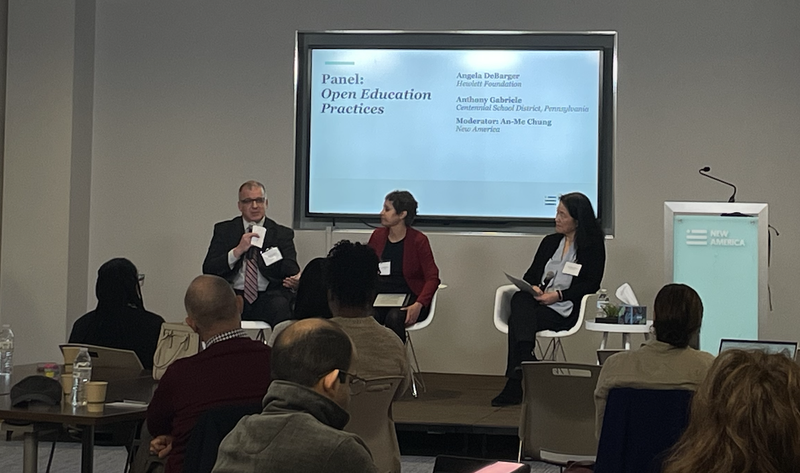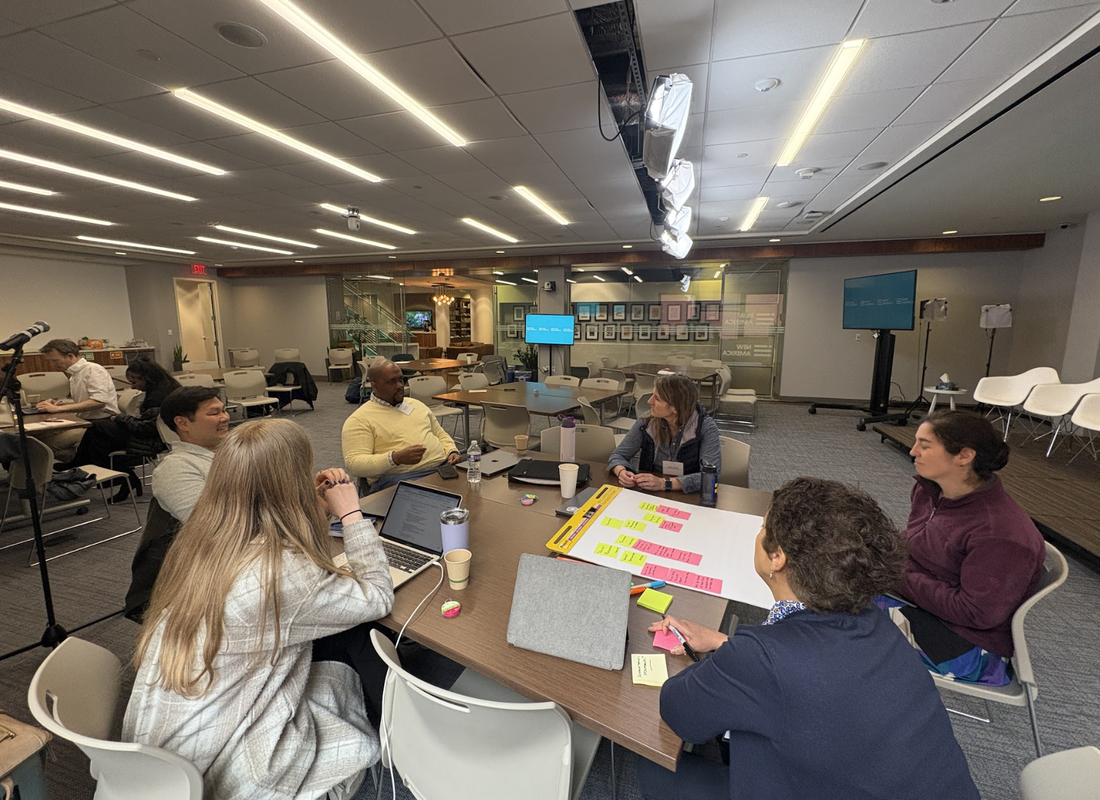Expanding OER in Public Education
A Conversation with Angela DeBarger and Anthony Gabriele on the power of open educational resources and practices
Blog Post

Source: An-Me Chung
July 11, 2025
Angela DeBarger, acting director, Education Program at the William and Flora Hewlett Foundation, and Anthony Gabriele, assistant to the superintendent for Academics and Student Services in Pennsylvania’s Centennial School District, bring complementary perspectives to the evolving role of open educational resources/practices (OER/P) in public education.
Angela’s work focuses on the intersection of deeper learning and OER/P, while Anthony draws on years of experience as a teacher and instructional leader integrating literacy, technology, curriculum, and open education tools.
On a recent panel hosted at the Education as Public Good Design Lab, Angela and Anthony discuss the opportunities of OER/P in changing how schools support equitable, high-quality learning.
Q: How do you explain open educational resources/practices (OER/P) for someone who may not know what it is?
Anthony: I have always like UNESCO’s definition, “Open Educational Resources (OER) are learning, teaching and research materials in any format and medium that reside in the public domain or are under copyright that have been released under an open license, that permit no-cost access, re-use, re-purpose, adaptation and redistribution by others.”
But I like to explain it like a recipe that's shared online: You can use it as-is, you can tweak it. By contrast, most traditional educational materials—like textbooks and curriculum packets—are more like a recipe someone owns (e.g., a restaurant).
Angela: As Anthony shared, OER are basically educational resources that are free for educators and students to use, customize, and share. They make it easier to incorporate content that connects with what students care about and help ensure that they have the most relevant and accurate information and tools to make sense of the world. Open educational practices (OEP) are what bring OER to life. We experience OEP when teachers curate and adapt OER and share what works (or doesn’t work) with their colleagues. Ideally, OEP also involves students as co-creators of knowledge and opportunities for students to collaborate with their peers.
Q: What have been the successes and challenges of implementing OER/P?
Angela: Based on research conducted by Bay View Analytics, nationally about one-third of teachers are now using OER as required or supplemental materials. One of the reasons for this success is the flexibility of OER. OER can be anything from a single lesson plan to an entire curriculum, which makes them easy to adopt and use. Teachers have options of leveraging lessons and units from resources like OER Commons, PhET Interactive Simulations, and PBLWorks. District and state leaders, who often have to consider fully scoped-and-sequenced materials for grade bands, have a number of high-quality OER options including CommonLit, Illustrative Mathematics, OpenSciEd, and Open Up Resources, as well as resources for teaching multilingual learners.
A challenge, however, is that scaling OER is sometimes in tension with co-creation. In other words, there is a perception that “high quality” OER needs to be treated more like a script to achieve intended outcomes rather than creating and supporting teachers in making productive adaptations that make the materials better for their students. We need more spaces where teachers collectively design and customize OER with their students’ real needs in mind.
This is where OEP comes into play. Ultimately, I believe success lies in the shift to co-created learning experiences—educators taking high-quality OER as a starting point and further enhancing it so that it engages their specific students. At the end of the day, open is not just about licensing—it’s about pedagogy. It’s about openly co-constructing learning experiences, not just delivering content.
Anthony: Success in both the Garnet Valley and Centennial School Districts came when we shifted our investments—from textbooks to teachers. By participating in initiatives like GoOpen and strengthening professional learning in curriculum and instructional design, we created collaborative spaces where educators could co-design “blueprint” courses using Open Educational Resources and Practices (OER/P) alongside frameworks like Understanding by Design (UbD) and Universal Design for Learning (UDL).
"Success in both the Garnet Valley and Centennial School Districts came when we shifted our investments—from textbooks to teachers"
In both districts, we’ve held a core belief: teachers are our most valuable resource. Yet for years, we were spending over half a million dollars annually on instructional materials developed outside the district. This disconnect between our beliefs and spending priorities prompted a strategic pivot—one that honored, invested in, and grew our teachers’ expertise.
By centering teacher leadership and carving out more time for individualized and small-group learning, we saw increased success for our students. Expanding student choice in learning modalities—whether brick-and-mortar, blended, or fully online—gave students the flexibility to balance their time, take ownership of their learning, and build skills for an ever-evolving digital future.
Of course, implementing OER/P came with challenges—chief among them were mindset shifts and time. Teachers (and sometimes leaders) often default to legacy structures and familiar strategies rooted in the past. Helping our central office, school administrators, and educators envision a future they couldn't yet see was essential.
To make that vision real, we had to rethink every part of the system: how we use time, how we design space, how we schedule, how we budget, and how we approach professional development, assessment, and instruction. Only by driving these systemic shifts could we support the systematic changes needed to create a more flexible, future-ready learning environment.

Educators, designers, and developers at the Education as a Public Good Design Lab
Source: An-Me Chung
Q: How can OER/P support education as a public good?
Angela: If education is a public good, that means a few things should be true. Knowledge should be available and accessible to everyone. We should have resilient and transparent systems for creating and sharing educational information and data. Our schools should strengthen and build connections with communities, and students develop the skills to be civically engaged and civically minded. OER/P advance every one of these goals. Openly licensing educational content democratizes access to knowledge, and embracing “open” demonstrates a commitment to building thoughtful infrastructure and policies for how data and information are used and shared, including advocating for responsible use of technologies like AI. Importantly, OER/P also creates intentional space to connect with learners’ interests and needs, so they have opportunities to shape their learning experiences.
"Openly licensing educational content democratizes access to knowledge, and embracing “open” demonstrates a commitment to building thoughtful infrastructure and policies for how data and information are used and shared"
Q: What is needed to expand and sustain OER/P?
Angela: If we want OER/P to be the default in education, then sustainability needs to be addressed technically and socially. This requires multi-layered support including continued awareness building to put OER on the radar of educators, ensuring there are high-quality OER options across the disciplines, intentional support for teachers to adapt and improve OER, and professional learning that gives teachers tools to encourage student contributions as creators of OER.
We also need better feedback loops for sharing effective practices and outcomes so that teachers can learn from each other and OER developers can improve their products and supports for educators. This may require new partnerships to facilitate a supportive ecosystem, and a great example of this is the OpenSciEd Research Community facilitated by Digital Promise, which brings together researchers, practitioners, and policymakers to expand research with the OpenSciEd program.
Anthony: Achieving meaningful, future-ready learning requires both systemic and systematic change—including shifts in budgeting, scheduling, and leadership. In both districts, expanding student choice in learning modality created the flexibility and time needed for deeper learning. But this didn’t come from simply introducing new technologies or resources—it required rethinking the entire system and aligning all its moving parts.
Greater buy-in and coordination at the county and state levels—especially in Pennsylvania—are essential. The state saw real momentum when it supported innovative efforts like Classrooms for the Future and PA Learns on iTunesU. Since 2014, PDE has created a presence on OER Commons. OER/P thrives when it’s a collective, shared effort. Currently, it exists in isolated pockets, with a few districts leading the charge. Without a cohesive vision, supportive infrastructure, and unified leadership, these efforts remain limited in scale and impact.
Q: What is the future of OER/P in the wake of AI?
Angela: With technologies changing so rapidly, it can be difficult to predict the future of OER/P with AI. We are already seeing examples of AI supporting the curation, remixing, and contextualizing of OER. With thoughtful prompts, AI can be helpful for developing assessments and question sets that provide students with more tailored opportunities to practice or connect new knowledge.
To be clear, I believe there will always be a role for educators who bring deep disciplinary expertise and knowledge of their students to manage and evaluate AI outputs. We also need to be cautious about ensuring that AI or any technology-enabled platform is not restricting education as a public good.
ISKME has put together Guiding Principles for Responsible AI in the World of Open, which acknowledges the importance of paying attention to where information and data come from, identifying partners whose primary goal isn’t about profit maximization, and taking a stance of continuous evaluation to make informed decisions. For anyone who wants to dig in further, I would also recommend the AI In Education articles published through the Inclusive Design Research Centre and the MIT AI + Open Education Initiative papers. These collections offer different perspectives on the promise and cautions when it comes to AI and open education.
Anthony: Our experience so far has shown that AI can help to support and accelerate the process of finding OER/P to meet instructional outcomes. As the repository of OER/P has grown, it has become increasingly more difficult to sort through and identify evidence-based, high quality OER. AI can help cut through some of the ‘noise’ in the OER/P space and save time in identifying resources that are authentic and purposeful in their support of student outcomes.